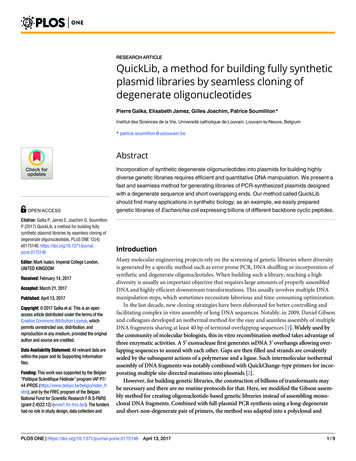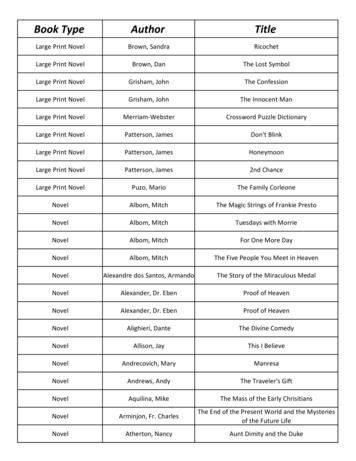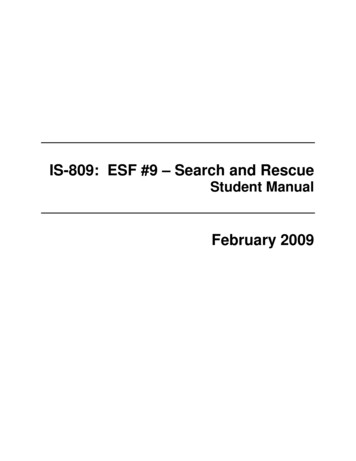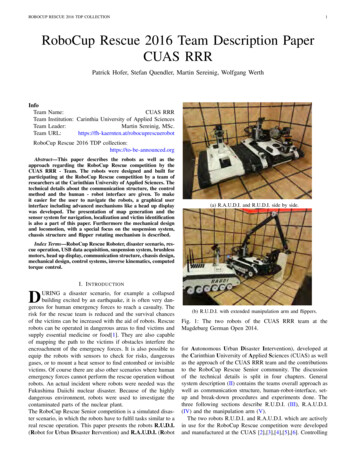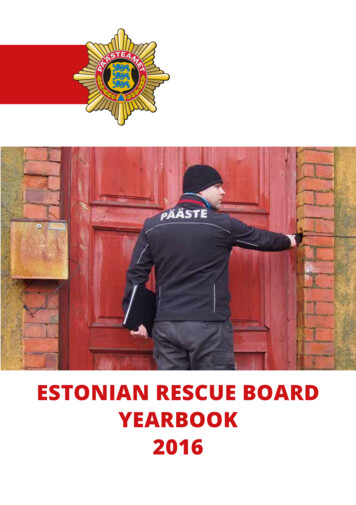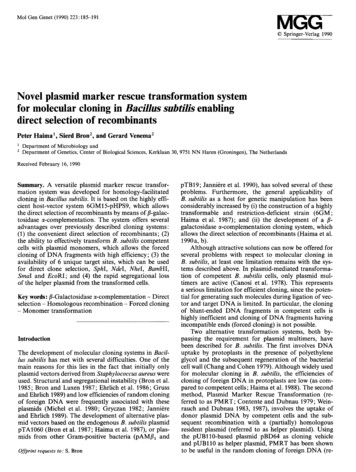
Transcription
Mol Gen Genet (1990) 223:185-191MGG(f:) Springer-Verlag1990Novel plasmid marker rescue transformationsystemfor molecular cloning in Bacillus subtiJjs enablingdirect selection of recombinantsPeterHaimal,1 Department2 DepartmentSierdBron2,andGerardof Microbiologyandof Genetics, Center of BiologicalVenema2Sciences, Kerklaan30, 9751 NN Haren (Groningen),The NetherlandsReceived February 16, 1990Summary. A versatile plasmid marker rescue transformation system was developed for homology-facilitatedcloning in Baci/lus subtilis. It is based on the highly efficient host-vector system 6GM15-pHPS9, which allowsthe direct selection of recombinants by means of p-galactosidase a-complementation. The system offers severaladvantages over previously described cloning systems :(1) the convenient direct selection of recombinants; (2)the ability to effectively transform B. subtilis competentcells with plasmid monomers, which allows the forcedcloning of DNA fragments with high efficiency; (3) theavailability of 6 unique target sites, which can be usedfor direct clone selection, Sphl, Ndel, Nhel, BamHI,Smal and EcoRI; and (4) the rapid segregational lossof the helper plasmid from the transformed cells.Key words: p-Galactosidase IX-complementation -Directselection -Homologous recombination -Forced cloning-Monomer transformationIntroduetionThe development of molecular cloning systems in Bacillus subtilis has met with several difficulties. One of themain reasons for this lies in the fact that initially onlyplasmid vectors derived from Staphylococcus aureus wereused. Structural and segregational instability (Bron et al.1985; Bron and Luxen 1987; Ehrlich et al. 1986; Grussand Ehrlich 1989) and low efficiencies of random cloningof foreign DNA were frequently associated with theseplasmids (Michel et al. 1980; Gryczan 1982; Janniereand Ehrlich 1989). The development of alternative plasmid vectors based on the endogenous B. subtilis plasmidpT A1 060 (Bron et al. 1987; Haima et al. 1987), or plasmids from other Gram-positive bacteria (pAMPl andOffprintrequests ta: s. BronpTB19; Janniere et al. 1990), has solved several of theseproblems. Furthermore, the general applicabilityofB. subtilis as a host for genetic manipulation has beenconsiderably increased by (i) the construction of a highlytransformabIe and restriction-deticientstrain (6GM ;Haima et al. 1987); and (ii) the development of a /3galactosidase (X-complementation cloning system, whichallows the direct selection of recombinants (Haima et al.1990a, b).Although attractive solutions can now be offered forseveral problems with respect to molecular cloning inB. subtilis, at least one limitation remains with the systems described above. In plasmid-mediated transformation of competent B. subtilis cells, only plasmid multimers are active (Canosi et al. 1978). This representsa serious limitation for efficient cloning, since the potential for generating such molecules during ligation of vector and target DNA is limited. In particular, the cloningof blunt-ended DNA fragments in competent cells ishighly inefticient and cloning of DNA fragments havingincompatible ends (forced cloning) is not possible.Two alternative transformation systems, both bypassing the requirement for plasmid multimers, havebeen described for B. subtilis. The tirst involves DNAuptake by protoplasts in the presence of polyethyleneglycol and the subsequent regeneration of the bacterialcell wall (Chang and Cohen 1979). Although widely usedfor molecular cloning in B. subtilis, the efticiencies ofcloning of foreign DNA in protoplasts are low (as compared to competent cells; Haima et al. 1988). The secondmethod, Plasmid Marker Rescue Transformation (referred to as PMR T ; Contente and Dubnau 1979; Weinrauch and Dubnau 1983, 1987), involves the uptake ofdonor plasmid DNA by competent cells and the subsequent recombination with a (partially) homologousresident plasmid (referred to as helper plasmid). Usingthe pUB110-based plasmid pBD64 as cloning vehicleand pUB110 as helper plasmid, PMRT has been shownto be useful in the random cloning of foreign DNA (re-
ferred to as homology-facilitated cloning; Gryczan et al.1980; Dubnau 1983). However, this system has at leastone major disadvantage: the high-copy-number helperplasmid pUB110 persisted in the transformed cells,which precluded the use of inactivation of the Kmr geneto screen for inserts.In the present investigations we have greatly improved PMR T , compared to " classical " systems, formolecular cloning in B. subtilis. A homology-facilitatedcloning system was developed in which the previouslydescribed p-galactosidase (X-complementation system,which is based on the low-copy-number stabIe plasmidpTA1060 (Bron et al. 1987; Haima et al. 1987, 1990a,b) was incorporated. The usefulness of this versatilesystem for molecular cloning in B. subtilis was demonstrated in a forced cloning experiment.Materials and methodsBacterial strains and plasmids. The bacterial strains andplasmids used are listed in Table 1.Media. TY medium was as described by Biswal et al.(1967). For Escherichia coli, chloramphenicol (Cm) wasused at 15 Jlg/ml, kanamycin (Km) at 50 Jlg/ml, erythromycin (Em) at 150 Jlg/ml, and Km plus Em at 50 Jlg/mleach. For B. subtilis, Km was used at 10 Jlg/ml, Cmat 5 Jlg/ml and Em at 1 Jlg/ml. 5-Bromo-4-chloro-3-indolyl-p-D-galactopyranoside (X Gal) was used at 40 Jlg/mlfor E. coli and at 80 Jlg/ml for B. subtilis.( Bio )chemicals. Chemicals were of analytical grade andwere obtained from Merck (Darmstadt, FRG) or BDH(Poole, England). Restriction enzymes, T4 DNA ligase,the Klenow fragment of E. coli DNA polymerase I andXGal were obtained from Boehringer (Mannheim,FRG).DNA techniques. Large-scale and mini preparations ofplasmid DNA were obtained essentially as described byIsh-Horowicz and Burke (1981). Other DNA techniqueswere as described by Maniatis et al. (1982). Monomericplasmid DNA was isolated from large-scale DNA preparations by electrophoresis on 0.6% agarose gels. DNAmigrating at the position of covalently closed monomerswas extracted from the gel. The monomeric DNA wasfurther purified by centrifugation in cesium chloride-ethidium bromide gradients.Competence and transformation. B. subtilis plasmid-freecells were grown to competence as described by Bronand Venerna (1972). For B. subtilis cells containing ahelper plasmid the same method was employed, withthe exception that the overnight culture was grownunder selective pressure. B. subtilis competent cells weretransformed with 1 !lg/ml plasmid DNA, for 30 min at37 C, unless stated otherwise. E. coli cells were madecompetent and transformed with 1 !lg/ml of plasmidDNA according to the CaCl2 procedure described byTable I. Strains and plasmids used in this studyRelevant propertiesSOUrCe 01referenceStrains :Bacillus subtilis6GMtrpC2 tyri- rMmMmet his ura rib6GM15trpC2 tyri met his ura ribr-M m M lacZL1Mi5 Km'Haimaet al. (1987)Haimaet al. (1990a)Escherichia coliMC1000F- ara D139 (ara ABC-leu)7679galK lacX74 rpsL thigalUWeinstocket al. (1983)PlasmidspHP34.8 kb, Cmr, Emr,pTA1060-pUC9 derivativePeeterset al(1988)pHP95.9 kb, Cmr, Emr, lacZIX,derivative of pHP3LaboratorycollectionpHP9R7.3 kb, Kmr, derivativeof pHP9This workpHP9D10.4 kb, Cmr, Tcr. derivative ofpHP9This workpHP9Do7.3 kb, Cmr, Emr, Kmr,derivative of pHP9This workpHP9R16.4 kb, Kmr, derivative of pHP9DoThis workpHP9D1100 pHP9Do 1.1kbE.coliDNAinsertThisworkpHP9D1600 pHP9Do 1.6 kb E. coli DNA insertThis workpHP9D3ooo pHP9Do 3 kb E. coli DNA insertThis workpHP9D4ooo pHP9Do 4 kb E. coli DNA insertThis workpHP9R27.9 kb, Kmr, derivativeof pHP9R1This workpHP9D18.8 kb, Cmr, Emr, Kmr,derivative of pHP9DoThis workpHPS95.6 kb, Cmr, Emr, cat-86::lacZIXHaimaet al. (1990a)pHP13-24.6 kb, Cm', Em',deletion derivative of pHP13Haimaet al. (1990a)pHPS9R4.1 kb, Em', derivativeof pHP13-2This workpEBl14Km', Ap', lac]Q, xylE,pUB110-pBR322 derivativeLeonhardtand AlonsopTB19Kmr, Tcr, natural isolatefrom a thermophilic bacilluslmanakaet al. (1981)pPJl4.0 kb, Apr, Kmr,pUC7 derivativePeeterset al. (1988)(1988)Maniatis et al. (1982). After exposure to plasmid DNA,cells of both E. coli and B. subtilis were diluted sixfoldwith TY medium and incubated at 37 C for 60 minto allow expression of antibiotic resistance markers.Transformants were usually selected on TY agar platescontaining the appropriate antibiotics at 37 C for 16 h.When p-galactosidase a-complementation in B. subtiliswas assayed, transformants were selected at 30 C for40h.
clI) ori-repe-reppTA1060 ' ,pTA1060--pHP9D (orlpUC': ::::--BclIC//--rnEKmr -Kmr- pHP9R1rFig. la-e. Vector-helper plasmid pairs used in this study. a PlasmidpHP9 was used for construction of all the plasmids shown. It wasconstructed by replacing the 581 bp FnuDII fragment from plasmidpHP3 (Peeterset al. 1988), containing the pBR322 origin of replication, by the 1630 b p AhaIII-AatII fragment from pUC9, containingthe pBR322 origin of replication and the lacZIX gene (YanischPerron et al. 1985). In Fig. 1b-e only regions relevant for PMR Tare shown on a linear scale. b Plasmid pHP9D contains the Tc'gene from plasmid pTB19 as a BamHI fragment in the Bc/I siteof plasmid pHP9. c, d Plasmid pHP9Do contains the Km' genefrom the Streptococcus faecalis plasmid pJH1 (Trieu-Cuot andCourvalin 1983), as a 1.4 kb BamHI fragment in the BamHI siteof pHP9. Plasmid pHP9R was constructed by filling in the NcoIand Bc/I sites ofplasmid pHP9Do. d In plasmid pHP9R1 the 0.9 kbregion between the NcoI and the Bc/I sites of pHP9Do was deleted.e Plasmids pHP9D1 and pHP9R2 were derived from pHP9Do andpHP9R1, respectively, by the insertion of a 1.7 kb EcoRI-PvuI fragment from plasmid pEB114. Escherjchja colj MC1000 transformants containing the desired recombinant plasmids were selectedon plates containing the appropriate antibiotics. Open bars, Emsequences;dashedbars, Cm sequences;closed bars, Km sequences;wavy ljnes, the 1.7 kb region from pEB114. Regions of homologyare drawn on the horizontallines; heterologous regions are shownas side-Ioops. Homologous regions of helper and donor plasmidsare alignedResultsthe heterologous target DNA was inserted (in the Bc/1site).In shotgun cloning the inserts will in general be cryptic and, therefore, can only be selected indirectly (inactivation of the Em' gene). This screening requires a highcorescue frequency of the vector (Cm') marker and thecloned insert (ideally 100%) to prevent the screeningof " false " recombinants. This consideration promptedMarkerrescue with " classical " vector-helper plasmidpairsWith the ultimate aim of developing an efficient andversatile homology-facilitated cloning system for B. subtilis, PMRT was studied with several vector-helper plasmid pairs (Fig. 1). AII plasmids used were based onpHP9 (Fig. 1 a), a derivative of the B. subtilis plasmidpTA1060, which was previously shown (Bron et al.1987; Haima et al. 1987) to be stabIe and efficient instandard shotgun cloning. The vector-helper plasmidpair pHP9D-pHP9R (Fig. 1 b) was analogous to vectorhelper plasmid pairs used in classical PMR T systems(Gryczan et al. 1980, except for the lower copy numbers(5 per chromosome equivalent)). The helper plasmidpHP9R carried inactivated Cm and Em genes (frameshifts produced by filling-in the NcoI and Bc/I sites, respectively) and was marked with a Kmr gene. The vectorplasmid, pHP9D, carried a Cmr gene which served asa selective vector marker, and an Emr gene into whichus to study several parameters affecting the corescuefrequency. With the pHP9D-pHP9R plasmid pair theeffect of large heterologous regions between the twoplasmids was tested, using a heterologous 4.5 kb fragment containing a Tc' marker as a model insert. Theselection of the desired clones (Cm' Tc') in this simulation experiment will require a double cross-over eventbetween donor and resident plasmid: one to the lef 1 ofthe NcoI site in the Cm' gene, and the other to theright of the Bc/1 site in the Em' gene.The results are shown in Table 1 (first row). B. subtilis 6GM competent cells, either plasmid-free or containing pHP9R, were transformed with monomeric pHP9D
188Table2. -pHP9R,transformationtransfornlantsperm!9.1 x3.1 x1.6x2.0x1.0x6.3 x7.5x6.0 xCotransferfrequency ofdonor andtarget marker 100bB. subtilis 6GM competent cells containing the appropriate helperplasmid were transformed with monomeric vector DNA at a concentration of 1.9 x 1011 molecules per ml. Transformants were selected on Cm-containing plates. The corescue frequency of donorand target marker was determined by: (1) toothpicking 500 Cmrtransformants onto plates containing Cm and Tc (pHP9RpHP9D); (2) plates containing Cm and Em (pHP9R-pHP9Do);or (3) by restriction analysis of randomly chosen transformants(PMRT experiments with helper plasmid pHP9RJ. The suffixes1100, 1600, 3000 and 4000 refer to the sizes of the inserts in thepHP9D plasmidsa Not determinedb Determined by restriction analysis of plasmid DNA extractedfrom 12 transformantsDNA. As in previously described PMRT systems (Contente and Dubnau 1979; Gryczan et al. 1980), monomeric plasmid DNA failed to transform plasmid-free cellsfor the donor marker (Cmr, results not shown). WhenpHP9R was present as helper plasmid, Cmr transformants were obtained at a high frequency (9 x 105/ml).The corescue frequency of the Cmr donor marker andthe Tcr marker, as determined by toothpicking 500 Cmrtransformants onto plates containing Cm plus Tc, appeared to be low: only 2%.Two possible explanations can be proposed for thelow frequency of corescue of donor marker and insertin the pHP9D-pHP9R system. The first is that the probability that one of the required cross-over events willoccur in the 0.9 kb homologous region between the NcoIand Bc/I sites, may be high. This would unlink donormarker and insert. The second possible explanation isbased on the notion that the heterologous region introduced by the 4.5 kb Tcr insert may interfere with theefficient corescue of donor marker and insert. In orderto discriminate between these possibilities, PMR T experiments were performed with the plasmid pair shown inFig. 1c.In the pHP9Do-pHP9R pair heterologous regionswere absent, except for the frame-shifts which inactivated the Cm and Em genes on pHP9R. When monomericpHP9Do DNA was used to transform 6GM(pHP9R)competent cells, Cmr transformants were obtained at ahigh frequency (3 x 106; Table 2), which is comparableto the frequency obtained with pHP9D-pHP9R(9 x105). However, the corescue frequency of the twomarkers on pHP9Do (Cmr and Emr, 70% cotransfer)greatly exceeded that obtained with the pHP9D-pHP9Rplasmid pair (2% cotransfer). Similarly high corescuefrequencies in the absence of large heterologous regionswere described by Weinrauch and Dubnau (1983), usingpUB110-based PMRT systems. These data indicate thatthe large nonhomologous region on the pHP9D vectorplasmid (Fig. 1 b) caused the dramatic reduction in thecorescue frequency of vector and target marker. Moreover, the presence of an additional heterologous region(the Kmr gene) in the pHP9D-pHP9R plasmid pair mayhave caused a further reduction in this corescue frequency.Optimizing the corescue frequency of donor and targetmarkerThe results described above indicate that in order tobe useful for molecular cloning, the corescue frequencyof vector and target marker should be high (ideally100%). In an attempt to realize this high efficiency ofcorescue, we constructed the vector-helper plasmid pairpHP9Do-pHP9Rlshown in Fig. 1 d. In the helper plasmid pHP9Rl, the 0.9 kb region between the NcoI andBc/I sites ofpHP9R was deleted, resulting in inactivationof the Cm and Em genes. By homologous recombinationbetween pHP9Do and pHP9Rl, which are completelyidentical except for the deleted part of the Cm-Em region, Cmr Emr transformants will be generated. However, pMR T of vector molecules with inserts in the Bc/Isite of the Emr gene, will result in Cmr Ems transformants. Since in this case no homology is present betweenthe donor marker (Cm) and the insert, a co transfer of100% was expected. Furthermore, it was expected that,due to the strong incompatibilitybetween vector andhelper plasmid (our unpublished results) and the lowcopy number (5 per chromosome equivalent), the nonrecombinant helper plasmid would be rapidly lost fromthe transformed cells under Cm selective pressure.To test this PMRT system, 6GM(pHP9Rl)competent cells were transformed to resistance to Cm withmonomeric pHP9Do DNA. The results (Table 2) showthat the transformation frequency obtained with thepHP9Do-pHP9Rlplasmid pair was about 6- to 20-foldless than that of the plasmid pairs pHP9D-pHP9R andpHP9Do-pHP9R. As expected, all Cmr transformantswere Emr (500 colonies tested), indicating that the 0.9 kbnonhomologous vector segment had been transferred tothe helper plasmid in all cases. This was corroboratedby restriction analysis of 24 randomly chosen transformants: all contained a plasmid identical to the vectorpHP9Do, and only low amounts of helper plasmid. Sincethe amount of helper plasmid DNA was at least 10-foldless than that of vector DNA, it can be concluded that,as expected, the helper plasmid was rapidly lost fromthe transformed cells.The observation that PMR T with pHP9Do-pHP9Rlwas 20-fold reduced as compared to the pair pHP9DopHP9R, suggests that the 0.9 kb nonhomologous regionbetween pHP9Do and pHP9Rl had a negative effect.Alternatiyely, the reduction in PMRT frequency mightbe caused by a lower total levelof homology (6.4 kbin pHP9Do and pHP9Rl;7.3 kb in pHP9Do andpHP9R). To examine this possibility, the extent of ho-
189-pHPsgR pUCEmr pHPS9NheI/ /NdeICAT-86::lacZcxFig.2. Vector-helper plasmid pair pHPS9/pHPS9R. Plasmid pHPS9R was constructed by deleting the 1.5 kb LacZIX region (nucleotides447-276; Yanisch-Perron et al. 1985) and part of the Cm' gene (region downstream of the NcoI site) of plasmid pHP13-2. Open bars,lacZIXsequences;closed bars, cat-86 sequences;dashedbars, CM sequences.Seethe legend to Fig. 1 for further detailsmology between pHP9Do and pHP9R1 was increasedby 1.5 kb with an additional insert from plasmidpEB114, resulting in vector pHP9D 1 and helper plasmidpHP9R2 (Fig. 1e). The frequency of PMR T with theseplasmids was almost identical to that obtained with thepHP9Do-pHP9R1 pair (Table 2). From these results itcan be concluded that the 0.9 kb nonhomologous regionbetween pHP9Do and pHP9R1 was responsible for thereduced PMR T frequency.insertions. In the helper plasmid pHPS9R, a deletionderivative of pHPS9, the 1.5 kb region of pHPS9, containing part of the Cmr gene (downstream of the NcoIsite) and the complete cat-86: : lacZa fusion was deleted.The transfer of the nonhomologous vector segment byhomologous recombination between donor and helperplasmid, was expected to result in Cmr LacZa trans-Effects of the size of the nonhomologous vector segmenton PMRTtransformants. This phenotype can be easily recognizedby the appearance ofwhite colonies on and6GM15(pHPS9R)competent cells were transformedwith pHPS9 DNA (the unfractionated plasmid mixture),and BamHI- or AsulI-cleaved pHPS9 DNA. Transformants were selected on plates containing Cm plus XGal.As in other PMR T systems (Contente and Dubnau 1979 ;Gryczan et al. 1980), linearized vector DNA failed totransform plasmid-free 6GM15 cells (Table 3). WhenpHPS9R was present in the cells, transformation withAsulI-cleaved vector DNA occurred at a relatively highfrequency (7.7 x 104/ml). The AsuII site is located in thehomologous region of donor and helper plasmid. In contrast, linearization of the vector in the nonhomologoussegment with BamHI, drastically reduced (about 250fold) the transformation frequency under PMR T conditions (to 3.0 x 102 transformants/ml). Furthermore, allCmr transformants resulting from PMR T with linearplasmid DNA, turned blue on XGal plates, suggestingthat the complete nonhomologous segment, includingthe cat-86: : lacZa fusion, had been transferred to thehelper plasmid. This was corroborated by restrictionanalysis of 24 randomly chosen transformants. All contained a plasmid identical to the donor pHPS9, in addition to small amounts of helper plasmid DNA (at least10-fold less than pHPS9).To test whether this PMR T system could be usedfor direct clone selection, a forced cloning experimentwas performed. Plasmid pHPS9 was digested withEcoRI and BamHI (both sites are located in the lacZaregion), and ligated to a heterologous E. coli EcoRIBamHI chromosomal fragment (3 kb). The ligationmixturewas used to transform6GM15and6GM15(pHPS9R) competent cells, and transformantswere selected on plates containing Cm plus XGal. The The observation described above might indicate thatPMR T efficiencies in general are negatively correlatedwith the size of the nonhomologous regions in the vectorplasmid. If so, PMR T systems might be of limited valuefor molecular cloning, since this would cause a bias infavor of small DNA inserts. To study whether such asize effect did exist, 6GM(pHP9R1) competent cells weretransformed with pHP9Do recombinant monomers, carrying heterologous E. coli DNA inserts (Haima et al.1987), ranging from 1100 to 4000 bp in size, in the Bc/1site. The results (Table 2) showed that the effect of insertlength on PMR T was very moderate. The increase inlength of the heterologous region from 900 bp inpHP9Do to 4900 bp in pHP9D4ooo resulted in only a3-fold reduction of the PMRT frequency. Restrictionanalysis of plasmid DNA extracted from 12 transformants obtained with each of these plasmids revealedthat all contained the correct recombinant plasmid.Homology-facilitatedcloningA major limitation of the PMR T system described aboveis the requirement for indirect selection of recombinants.To facilitate direct clone selection, we constructed a novel PMR T system, in which the recently described f3-galactosidase IX-complementation system for B. subtilis wasincorporated (Haima et al. 1990a, b). The host (6GM15)used in this system contained a constitutively expressedlacZAM15 gene integrated as a single copy into the chromosome. The vector-helper plasmid pair is shown inFig. 2. The vector (pHPS9) contained a Cm" gene asa selectable marker, and a constitutively expressed translational fusion of the B. pumilis cat-86 gene and thepUC9-derived lacZIX gene as target marker for DNAformants. In contrast, PMR T of vector molecules carrying inserts in one of the unique target sites of thecat-86: : lacZa fusion, would result in Cmr LacZa -
PS9-BamHIpHPS9-AsuIIpHPS9- EcoRI BamHI(forced x1063.0 x 1027.7x104ooo963.1 x 10598007.1xl03Cm'trafisformafitsperm!(% )Unfractionated pHPS9 DNAs, isolated from B. subtilis, were treated as indicated. a For the forcedcloning experiment, BamHI-EcoRI-cleaved pHPS9 DNA was ligated to a 3 kb heterologous EcoRIBamHI E. coli chromosomal DNA fragment at a mass ratio of 1: 1 and a final DNA concentrationof 100 J.lg/ml. The plasmid DNAs and the ligation mixture were used to transform 6GM15 and6GM15(pHPS9R) competent cells and transformants were selected on plates containing Cm plus XGal.The concentration of plasmid pHPS9 in the transformation mixtures was 1 J.lg/mlcompetent cellsresults (Table 3) showed that this PMR T system can besuccessfully used for forced cloning and, consequently,for cloning with plasmid monomers. Approximately 3 x105 transformants per ml of competent cells were obtained under PMRT conditions, among which 98%showed no p-galactosidase activity. Restriction analysisof 24 randomly chosen potential clones revealed thatall contained recombinant pHPS9 plasmids carrying the3 kb EcoRI-BamHI fragment. In plasmid-free cells, theyield of potential clones was about 45 times less. Alsoin this case, all potential clones tested (24), appearedto contain recombinant pHPS9 plasmids, carrying the3 kb EcoRI-BamHI fragment. The unexpected findingthat some clones were also obtained in plasmid-free cells,was most likely due to incomplete digestion of the vector: the presence of even low amounts of molecules partially digested with EcoRI or BamHI would allow thegeneration of multimeric molecules during ligation.From these results it can be concluded that the PMR Tsystem described here can be successfully used for forcedcloning with direct clone selection in B. subtilis.DiscussionThe low yields of clones generally obtained in shotguncloning in B. subtilis have mainly been attributed to thefailure of plasmid monomers to transform B. subtiliscompetent cells. In a previous study we have shown thatprotoplast transformation, which does not require multimers, does not offer a satisfactory solution to this problem, since the yields oftransformants using ligated DNAwere relatively low (Haima et al. 1988). PMR T , whichallows for the efficient transformation of competent cellswith plasmid monomers, was shown to be highly efficient in transformation with ligated DNA (Gryczanet al. 1980). We therefore considered this method to bepotentially valuable for direct cloning in B. subtilis. Thepiimary aim of the present study was to develop sucha system. To this end we have analyzed several parame-ters affecting PMR T by using several vector-helper plasmid pairs, all based on the B. subtilis plasmid pTA1060.We have previously shown that this plasmid is stablymaintained (Bron et al. 1987) and efficient in standardshotgun cloning (Haima et al. 1987).One of the most important factors ad ding to thevalue of PMR T for molecular cloning appears to bethe corescue frequency of the selective vector markerand the cloned insert. Using classical-type vector-helperplasmid pairs, it was shown that the presence of a largenonhomologous region on the vector plasmid (4.5 kb)reduced this corescue frequency drastically (35-fold).The corescue frequency of vector and target marker wasoptimized using a novel PMR T system, based on thevector-helper plasmid pair pHP9Do-pHP9Rl, which differed from previously described systems in that the vector and target markers were partly present in a small(0.9 kb) nonhomologous vector region. The corescue frequency of vector and target marker in this system was100%, irrespective of the presence of large heterologousinserts (up to 4 kb inserts were tested) in the targetmarker.PMRT with the plasmid pair pHP9Do-pHP9Rlisreduced 20-fold compared to the almost completely homologous pair pHP9Do-pHP9R. Although the efficiencies in other PMR T systems have been reported to depend strongly on the levelof homology between vectorand helper plasmid (Weinrauch and Dubnau 1983), theobserved reduction in our system appeared not to becaused by lower total homology between pHP9Do andpHP9Rl (6.4 kb) compared to pHP9Do and pHP9R(7.3 kb). It was therefore concluded that the 0.9 kb nonhomologous vector region between pHP9Do andpHP9Rl was responsible for the reduction in PMRTefficiency. The effect of the size of the nonhomologoussegment in vector pHP9Do on PMR T appeared to bevery moderate. An increase in the size of the heterologous region from 900 b p to 4900 b p resulted in onlya 3-fold reduction of the PMR T efficiency. This reduction is most easily explained by the fact that plasmid
191molecules are randomly linearized during DNA uptakeby competent cells (de Vos et al. 1981). The probabilitythat the linearizing cut will occur in the nonhomologousvector segment, thus preventing PMRT (Contente andDubnau 1979), will increase as a function of the sizeof the nonhomologous vector segment.Altogether, these results show that the PMRT systemdescribed offers several advantages over previously described systems. The advantages include: (1) highly efficient transformation with monomeric plasmid DNA; (2)transformation efficiencies which are only slightly dependent on the size of the DNA inserts (at least in therange of 900--4900 bp) ; and (3) 100% corescue of donorand target marker (which facilitates screening for insertsvia marker inactivation). A considerable additional advantage over previously described PMR T systems concerns the rapid segregational loss of the helper plasmidfrom the transformed cells. Due to strong incompatibilitY between vector and helper plasmid and its low copYnumber (5 per chromosome equivalent), the helper plasmid was rapidly lost from the transformed cells (theamount of helper plasmid DNA was at least 10-foldless than that of vector DNA).The optimal PMR T system described here incorporated the recently developed f3-galactosidase IX-complementation system for B. subtilis (Haima et al. 1990a,b). This system combines all the positive aspects of thePMR T system described above and, in addition, offers :(i) the convenient direct selection of recombinants; (ii)the forced cloning of heterologous DNA fragments withhigh efficiency; and (iii) the availability of 6 unique target sites for direct selection cloning, Sphl, Ndel, Nhel,BamHI, Smal and EcoRI. In addition to the demonstrated use for forced cloning, we expect that this PMR Tsystem is likely to be valuable for further increasing theefficiencies of random cloning of foreign DNA in B.subtilis.Acknowledgements.We thank Henk Mulder for preparingthe figures. Funding for this project was provided by Koninklijke GistbrocadesN .V., Delft, The Netherlands.ReferencesBiswal N, Kleinschmidt AK, Spatz HC, Trautner TA (1967) Physical properties of the DNA of bacteriophage SP50. Mol GenGenet 100:39-55Bron S, Luxen E (1987) Segregational instability of pUB110-derived recombinant plasmids in Bacillus subtilis. Plasmid 14: 235244Bron S, Venerna G (1972) Ultraviolet inactivation and excisionrepair in Bacillus subtilis: I. Construction and characterizationof a transform
for molecular cloning in B. subtilis, the efticiencies of cloning of foreign DNA in protoplasts are low (as com-pared to competent cells; Haima et al. 1988). The second method, Plasmid Marker Rescue Transformation (re-ferred to as PMR T ; Contente and Dubnau 1979; Wein-rauch and Dubnau 1983, 1987), involves the uptake of

